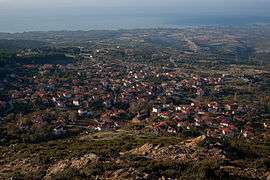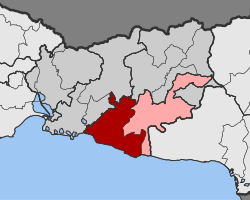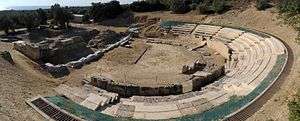Maroneia
Maroneia (Greek: Μαρώνεια) is a village and a former municipality in Rhodope regional unit, East Macedonia and Thrace, Greece. Since the 2011 local government reform it is part of the municipality Maroneia-Sapes, of which it is a municipal unit.[2] The municipal unit has an area of 287.155 km2.[3] Population 6,350 (2011). The seat of the municipality was in Xylagani.
Maroneia Μαρώνεια | |
|---|---|
 | |
 Maroneia Location within the regional unit  | |
| Coordinates: 40°54′N 25°31′E | |
| Country | Greece |
| Administrative region | East Macedonia and Thrace |
| Regional unit | Rhodope |
| Municipality | Maroneia-Sapes |
| • Municipal unit | 287.2 km2 (110.9 sq mi) |
| Population (2011)[1] | |
| • Municipal unit | 6,350 |
| • Municipal unit density | 22/km2 (57/sq mi) |
| Community | |
| • Population | 570 (2011) |
| Time zone | UTC+2 (EET) |
| • Summer (DST) | UTC+3 (EEST) |
| Vehicle registration | ΚΟ |


History
In legend, it was said to have been founded by Maron, a son of Dionysus,[4] or even a companion of Osiris.[5] According to Pseudo-Scymnus it was founded by Chios in the fourth year of the fifty-ninth Olympiad (540 BCE).[6] According to Pliny, its ancient name was Ortagures or Ortagurea.[7] It was located on the hill of Agios Charalampos,[8] and archaeological findings date it as a much older and as a pure Thracian city. Herodotus says it belonged to the Cicones.[9]`
Maroneia was close to the Ismaros mentioned by Homer in the Odyssey.[10] Some scholars identify Maroneia with his Ismaros.[11] Homer has Odysseus plundering the city but sparing Maron, whom he identifies as a priest of Apollo. Maron presents Odysseus with a gift of wine, as well as with gold and silver.
In the era of Ancient Greece and Rome, Maroneia was famous for its wine production. The wine was esteemed everywhere; it was said to possess the odor of nectar,[12] and to be capable of mixture with twenty or more times its quantity with water.[13] That the people of Maroneia venerated Dionysus, we learn not just from its famous Dionysian Sanctuary, the foundations of which can still be seen today, but also from the city's coins. It was a member of the Delian League.[14]
In 200 BCE it was taken by Philip V of Macedon; and when he was ordered by the Romans to evacuate the towns of Thrace, he vented his rage by slaughtering a great number of the inhabitants of the city.[15] The Roman Republic subsequently granted Maroneia to Attalus, King of Pergamon, but almost immediately revoked their gift and declared it a free city.[16]
Maroneia was the largest and most important of all ancient Greek colonies of Western Thrace. The city owed its prosperity to the extensive and rich territory and also to the port which favored the development of intense commercial activity. Furthermore, Romans had granted many privileges to the city, such as the proclamation its freedom and the increase of its territory, where a dense network of rural settlements was developed.[17]
In December 1877 Captain Petko Voyvoda overthrew the Ottoman rule and established a free administration in the town.
It is the seat of a Roman Catholic titular bishopric called Maronea.[18]
Notable people
- Metrocles (4th century BC), Cynic philosopher
- Hipparchia, Cynic philosopher and sister of Metrocles
- Sotades (3rd century BC), poet
- Petko Kiryakov (Captain Petko Voyvoda) (1844–1900), Bulgarian politician and leader of the national revolution
- Archbishop Michael of America (1892-1958)
Notes
- "Απογραφή Πληθυσμού - Κατοικιών 2011. ΜΟΝΙΜΟΣ Πληθυσμός" (in Greek). Hellenic Statistical Authority.
- Kallikratis law Greece Ministry of Interior (in Greek)
- "Population & housing census 2001 (incl. area and average elevation)" (PDF) (in Greek). National Statistical Service of Greece. Archived from the original (PDF) on 2015-09-21.
- Euripides, Cyclops, v. 100, 141
- Diodorus Siculus. Bibliotheca historica (Historical Library). 1.20.
- Pseudo-Scymnus, 675 ff
- Pliny. Naturalis Historia. 4.11.18.
- Lund University. Digital Atlas of the Roman Empire.
- Herodotus. Histories. 7.109.
- Homer, Odyssey, ix. 196-211
- Isaac, B., (1986), The Greek Settlements in Thrace Until the Macedonian Conquest, page 113. BRILL.
- Nonnus, i. 12, xvii. 6, xix. 11
- Homer, Odyssey, ix. 209; Pliny, xiv. 4. s. 6
- Athenian Tribute Lists
- Livy, xxxi. 16; xxxix. 24; Polybius, xxii. 6, 13, xxiii. 11, 13
- Polybius, xxx. 3
- D. C. Samsaris, Historical Geography of Western Thrace during the Roman Antiquity (in Greek), Thessaloniki 2005, p. 97-108
- "Maronea". catholic-hierarchy.org. Retrieved 8 July 2017.
![]()
Sources
- Durando, Furio, Greece: A Guide to the Archaeological Sites, 2004.
- Herbermann, Charles, ed. (1913). . Catholic Encyclopedia. New York: Robert Appleton Company.
- Smith, William, (1857), Dictionary of Greek and Roman Geography.
- Psoma, Selene, Chryssa Karadima and Domna Terzopoulou, The Coins from Maroneia and the Classical City at Molyvoti: A Contribution to the History of Aegean Thrace (Athens: Diffusion de Boccard, 2008) (Meletemata, 62).
| Wikimedia Commons has media related to Maroneia. |
| Wikivoyage has a travel guide for Maroneia. |